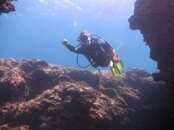Lynne,
Thanks. I love that being associated with my students. Im super proud of them and their accomplishments. If others are doing that I'm even more excited.
The wonderful thing about this sport is that there are so many differences of opinions.

we learn from everyone.
Generally i try not to teach on line, but since i was mentioned here, and many of my students lurk here thought i would share some.

Yes, I train all my students with this concept. It is for good reason. I'm understanding that not everyone appreciates it, however that will never change my approach as it offers many significant benefits, and I personally dive in that position for hours. Just ask anyone who is ever in the water with me. In fact, it is UNCOMFORTABLE not to be in that position. There are of course some variations, and once control is established, people relax their shoulders (lower) to increase field of vision.
I accept that some don't care to be in trim, or that a few degrees off causing minimal drag is insignificant from a performance perspective. That said, I want to demonstrate the highest performance possible. If others strive to meet or exceed that awesome. If not, that's ok too. It's a tool!
In teaching, to get one from a-z in the shortest time possible, you need to minimize the variable to control the outcome. This position helps with that.
Often students come with less than helpful feedback on how to improve their performance. Arms up high allows me, or any individual with instant feedback about their personal position, eliminating the need for outside/questionable replies. It allows constant information of depth, time, gas, and teammates position without needing to split attention in order to gain that information.
Once one has stability and a base of control, they are able to to do almost anything they desire. Getting to that point takes time and effort. Just go to any recreational dive site and look around and no one would deny the difference between those who have it and those who don't.
I try to look back over my history of diving and remember how along the way I was better or worse, and what steps it took to improve my personal performance. There were times i was a total mess. A snap shot of any one of those time frames is just that and represents almost nothing other than a single data point in a lifelong project including millions of data points.
Having trained hundreds of people with just about every ailment possible, bad necks, shoulders, arms, missing fingers, unusable arms, even missing legs, I appreciate those challenges. All of that in pursuit of control and comfort.
Once you have it, how you use it is entirely up to the individual. Stable people can place their arms and legs and head and hands wherever they want and still demonstrate control. Unstable people.....not so much

I believe that we play the way we practice, so one should practice the way one wants to play. I respect that opinions differ. But, I try to remember that people are in different places, and the path forward from wherever they are, might be the same or different to where YOU are. Committ to helping everyone that wants to improve to improve with whatever tools available without offending those who don't. No small task

Thanks all for sharing, best, bob. 607-765-3942
Litehedded, I used to associate this with Bob Sherwood's students, but I guess it's generalized now.





